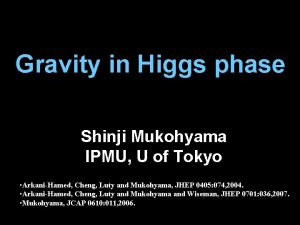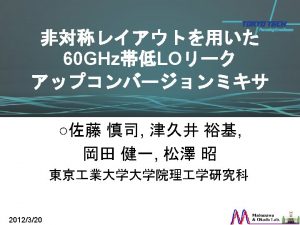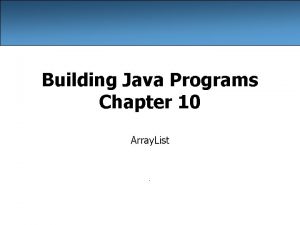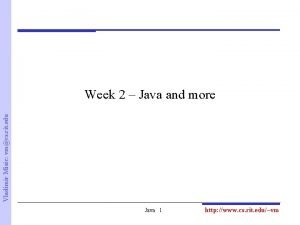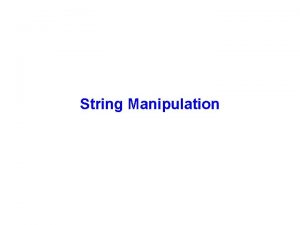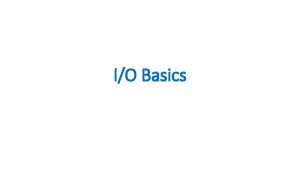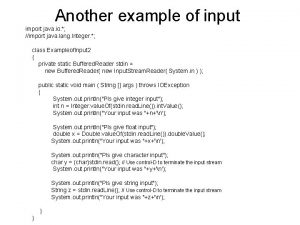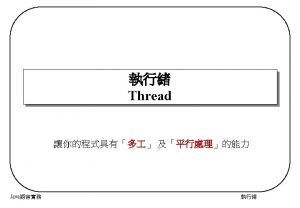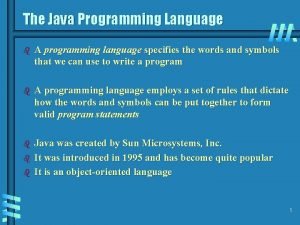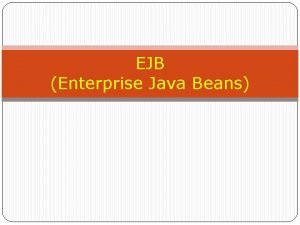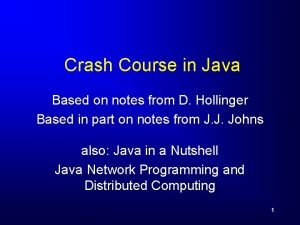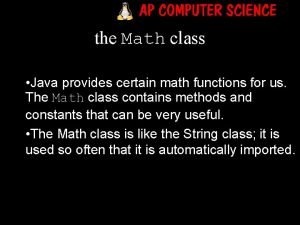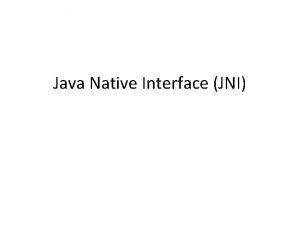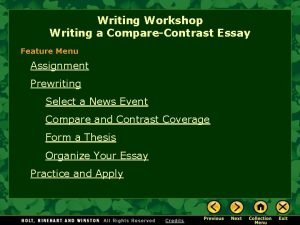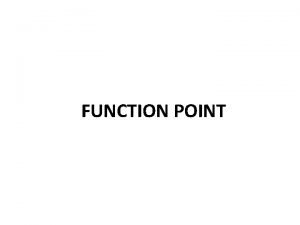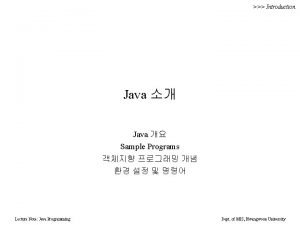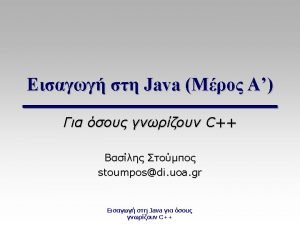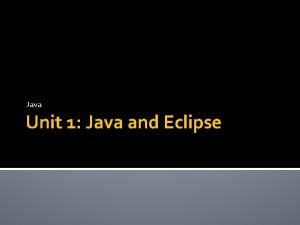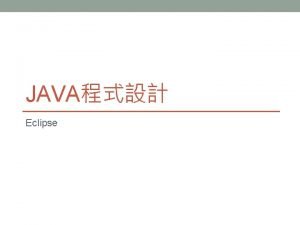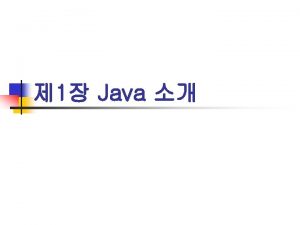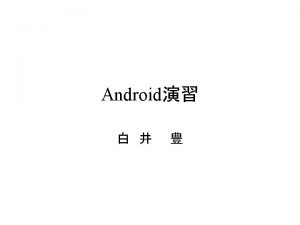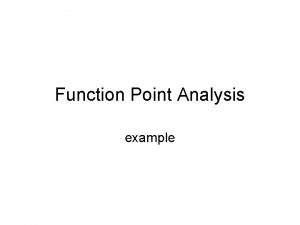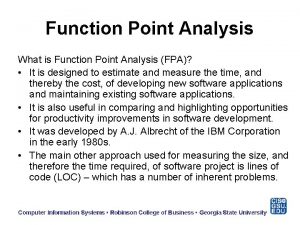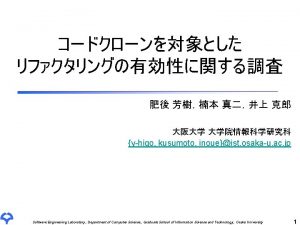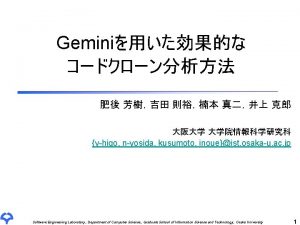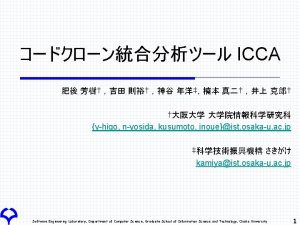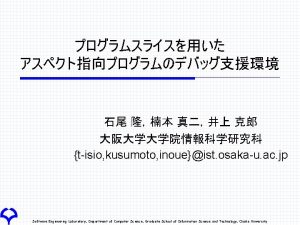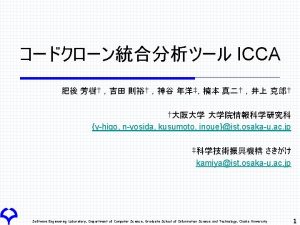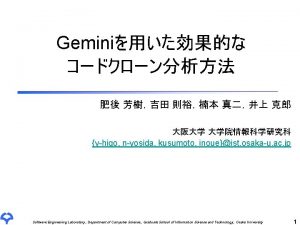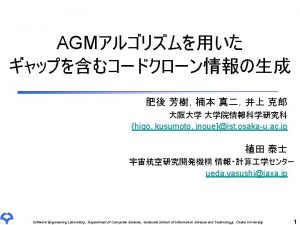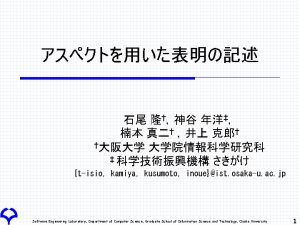Function Point Measurement from Java Programs Shinji Kusumoto

























- Slides: 25

Function Point Measurement from Java Programs Shinji Kusumoto+, Masahiro Imagawa+, Katsuro Inoue Shuuma Morimoto$, Kouji Matsusita$, Michio Tsuda$ +Osaka University $Hitachi System & Service, Ltd. +

Background(1/3) Function point analysis(FPA) was proposed to help measure the functionality of the application software. effort (person-months) 300 0 2000 FP 2

Background(2/3) Issues: • Since FP counting involves judgement on the part of the counter, some difference for the same product would be caused. • In order to introduce FPA to an organization, it is necessary to count FP from the software developed in the past as experience data. 3

Background (3/3) • Automatic FP measurement from objectoriented software. – FP measurement tool from UML diagrams* • Demand to measure function point from source code. – Functional differences between requirements/design specification and source code. – Existence of source code without specifications. * T. Uemura, S. Kusumoto and K. Inoue: ``Function point analysis for design specifications based on the Unified Modeling Language'', Journal of Software Maintenance and Evolution, Vol. 13, No. 4, pp. 223 -243 (2001). 4

Objective of the reserach • We examine the possibility to measure function point from source code automatically. – Propose measurement rules to count data and transactional functions from object oriented program based on IFPUG method. – Develop the function point measurement tool based on the rules. – Apply the tool to practical Java programs in Hitachi Systems & Services 5

Function Point Analysis FPA is a technique that functions are classified into the following element, and then measures the functionality. – Data function • Internal and external data requirements – Transactional function • Represent the functionality provided to the user for the processing of data by an application USER Input Output Inquiry Internal data External data Application Software 6

Definition of Data Function types • Internal Logical File(ILF) : – user identifiable group of data. – maintained within the system. • External Interface File(EIF) : – user identifiable group of data. – not maintained by the system. • Each ILF or EIF has a functional complexity based on the number of data of it. 7

Definition of Transactional Function types • External input(EI): – processes data that come from outside the software. • External output(EO): – generates data sent outside the software. • External inquiry(EQ): – is a process made up of an input-output combination that results in data retrieval. • Each EI, EO or EQ also has a functional complexity based on the number of data processed. 8

Key Idea (1/2) • It is difficult to judge the types of functions only from the static information of source codes. • We use the dynamic information collected from the program execution based on a set of testcases which should correspond to all functions of the target program. – Testcases for acceptance test 9

Key Idea (2/2) class. A message class. B class. C class. D • It shows an interaction, which is a set of messages exchanged among the classes, like a sequence diagram. We call this kind of sequence as method calling sequence. • We measure FP by analyzing the messages and the information of the classes in the sequence constructed by each testcase. 10

Counting Data Function Types(1/2) • From our previous experience most classes on the object-oriented requirements/design specification directly corresponded to data functions. • We assume that the function point analyst select the classes that would be the data functions from the program. 11

Counting Data Function Types(2/2) • Classify DF into two types: – ILF: During the program execution, the classes some of which methods are called with some arguments are regarded as ILF. – EIF: Other classes that are not regarded as ILF, are regarded as EIF. class. X class. Y(DF) Y. method (arguments) 12

Counting Transactional Function Types(1) • • Regarding the classes as data functions, the method that updates or refers to the data in the class can be used to extract the transactional function. Basic element in the method calling sequence – Sub-method calling sequence where a method, that is defined in a data function class, is called by other class. A class. B(DF) B. method class. A(DF) class. B(DF) B. method 13

Counting Transactional Function Types(2) • Step 1: – Calculate the method calling sequences for all testcases. – Set application boundary (classes whose methods are inevitably called when the user input some data. ex. GUI classes or Java Servlet classes ) class. A (Boundary class) class. B class. C class. D (DF) D. method 14

Counting Transactional Function Types(3) Step 2: – Extract the method calling sequences where the basic element is appeared. class. A class. B class. C class. D (DF) D. method 15

Counting Transactional Function Types(4) Step 3: Identify the type of transactional functions: (1)External Input (EI) is the sequences that include the following pattern. class. A (Boundary class) class. B class. C (DF) C. method(X) 16

Counting Transactional Function Types(5) (2) External Output (EO) is the sequences that include the following pattern. class. A class. B (Boundary class. C (DF) (halfway class) C. method(0) (3) External Inquiry (EQ) is the sequences not satisfying the above pattern. 17

FP measurement tool (1/2) Java Programs Syntax Analysis Unit Test Case Execution Unit (JVMPI) Syntax Information File Execution Log File Data Function Class Boundary Class FP calculation Unit FP results 18

Screen of FP measurement tool 19

Case study(1): Target application is a typical Web application that has been developed based on the object oriented approach. Database server Application server Java Program Web server Brow ser゙ Java Servlet Components for DB access J D B C Oracle8i HTML CSV HTML We compare the FP values by our tool with ones by a Function Point specialist of Hitachi System & Services, Ltd. 20

Case study (2) Result Data function Transactional function FP total Tool Specialist ILF 11 4 EIF 1 7 EI 9 6 EO 13 14 EQ 0 0 174 170 21

Case study (3) Analysis of DF • By selecting the classes, that conceal the access to database, as data functions, the number of data functions are quite similar. • The classification result of data function types are different between the tool and the specialist. – The result is due to the fact that most methods in the data function class have arguments. • It is necessary to revise the classification rule. For example, if the argument of the method in a class indicates the meaningful data, the class is regarded as ILF. 22

Case study (4) Analysis of TF • Both the number of transactional functions by the tool and the specialist are quite similar. – Each of the transactional functions counted by the specialist was also counted by the tool. • The tool counted two transactional functions excessively. 23

Example class. X (Boundary class) class. B class. C(DF) class. D class. Y (Boundary class) class. B class. C(DF) class. D (1) (2) 24

Conclusions • We have examined the possibility to measure function point from source code automatically. – Proposed measurement rules. – Developed the FP measurement tool. – Applied the tool to practical Java programs. • It is necessary to – apply the proposed tool to other programs which include EQ. – revise the rule of the classification of each function. 25
 Arkani-hamed
Arkani-hamed Sato active
Sato active Shinji tsujikawa
Shinji tsujikawa Collection of programs written to service other programs.
Collection of programs written to service other programs. Java array programs exercise
Java array programs exercise Vladimir misic
Vladimir misic Java string manipulation
Java string manipulation Java programs perform i/o through ……….. *
Java programs perform i/o through ……….. * Import java.lang.*
Import java.lang.* Import java.util.*
Import java.util.* Import javax.swing.*
Import javax.swing.* Import util scanner
Import util scanner Import java.io.file
Import java.io.file Import java.util.*
Import java.util.* Import java.util.random;
Import java.util.random; What is readline in java
What is readline in java Import java.util.
Import java.util. Java import java.io.*
Java import java.io.* Pengertian awt dan swing pada java
Pengertian awt dan swing pada java Import java.awt.event
Import java.awt.event Java compiler translates java source code into
Java compiler translates java source code into Ejb remote vs local
Ejb remote vs local Java point
Java point Java math class functions
Java math class functions Getfloatarrayelements
Getfloatarrayelements Point by point block method
Point by point block method
